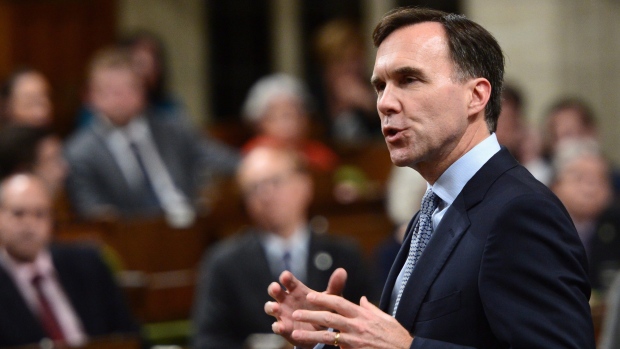Oct 23, 2017
Morneau not expected to deliver what Bay Street wants in fall update
By Greg Bonnell

The Trudeau Liberals will “brag and boast” about Canada’s economic growth as they deliver the fall economic statement Tuesday, but Bay Street would prefer to hear about a path back to fiscal balance.
The surprisingly strong economic performance in the second quarter has the potential to shave billions from Ottawa’s budgetary deficits, but only if that money isn’t earmarked for new spending initiatives.
“I would like to see zero growth in program spending in recognition of full employment, and a path to a balanced budget by 2020,” David Baskin, president of Baskin Wealth Management, told BNN in an email.
“I would like to see less direct government intervention in the economy and I would like to see no increases in personal taxes.”
That said, Baskin isn’t holding out much hope that his wishes will come true.
“What I would like to see and what we will see are, of course, vastly different.”
In the spring budget, Finance Minister Bill Morneau pencilled in 1.9 per cent growth for the Canadian economy this year, based on private sector estimates, and built his fiscal plan around that assumption.
- Trudeau praises Morneau for 'going above and beyond' ahead of update
- 'I need to do more': Morneau vows to set up blind trust after complaints
- Morneau backtracks on capital gains proposal
MORE ON MORNEAU
Fast forward to October, and Canada is leading the G7 in growth.
RBC Economics is now expecting 3.1 per cent real GDP growth this year. While an upside surprise of one percentage point can boost the bottom line by some $4.5 billion a year, RBC points out higher interest rates cut into that strength through higher funding costs.
“Overall, stronger growth and higher interest rates should trim the projected deficit by about $4 billion in the current fiscal year and $3 billion annually over the next four fiscal years,” RBC economist Josh Nye wrote in a report Friday.
Greater fiscal restraint would be needed to turn that economic good news into balanced budgets, he adds.
“We think the government’s improved fiscal position would be put to better use by returning to a balanced budget.”
Even talking about a return to balance is a sharp reversal from projections laid out at the end of last year, when the Finance Department forecast annual shortfalls until at least 2050-51 if the Liberals didn’t change course.
And according to the RBC analysis, the fiscal position has improved significantly since the spring budget — which set out a $28.5-billion shortfall for 2017-18.
RBC says the stronger economy could shrink that number by a whopping $10 billion, adding if the $3 billion risk cushion is also removed the deficit could be brought down to $15 billion.
While the economy has been strong, a number of challenges – including NAFTA renegotiations and cooling housing markets facing more regulation – are raising concern about growth in the coming months and years.
“Yes, we had a big second quarter, which they’ll brag and boast about; but we’ve yet to see the third quarter,” David Prince, founder and president of Harbinger Capital Market Research, told BNN in a phone interview.
“If the growth is that good, why do they keep insisting on running a deficit?”
A rebound in the resources sector from the depressed levels of 2016 has been a big driver of growth, but Prince says that economic engine isn’t sustainable.
“Clearly not with all the stuff that’s been cancelled lately,” said Prince, alluding to TransCanada’s recently mothballed Energy East pipeline project.
The fall economic statement also comes amid an uproar over the Liberals’ plan to target tax strategies employed by Canadians who are privately incorporated.
Morneau spent last week tweaking the plan in the hopes of quelling the dissent from small business and big name entrepreneurs.
“I'm hoping the finance minister continues to walk back his dangerous proposals which won't level any playing field but will likely trigger a significant economic setback,” David Rosenberg, chief economist and strategist at Gluskin Sheff + Associates, told BNN in an email.
And with tensions on the rise in NAFTA talks, Rosenberg says he wants to know what Ottawa’s “Plan B” is when it comes to potential economic challenges ahead.
“In the final analysis, any fiscal update should be used as a tool to reduce uncertainty.”


